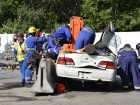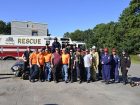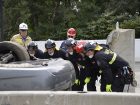
Remember when you were first hired? Think back to that feeling where you were once full of bright optimism and a youthful mind-sponge ready for anything fire-related thrown at you during your recruit class.
With the highest hopes that this would always be the way our 20-to-30-plus years in the fire service would remain, some of us may find that it dwindled after the first few years.
While this is hopefully not the case, it may be for many of us in the modern-day fire service where hands-on training time is at a premium.
To combat this, sometimes we need to branch out from our usual department-mandated training and grasp onto something that stimulates our fire-service minds. Step into the world of the auto extrication challenge.
A little more than eight years ago, I was introduced to our department’s auto extrication team and haven’t looked back since.
From cutting apart cars two to three times a month to learning about proper stabilization and how it applies to auto extrication and many other areas in the fire service, this team was a no-brainer for myself and many others that have come and gone over the years. The ability to obtain first-hand tool knowledge, new technology and patient care were also huge advantages of this program. And let’s not forget about that comradery thing. With constantly-expanding departments, longer shifts and greater commute times, the auto extrication world has provided a much-needed jolt to our culture that allows team members from all shifts and departments all over the world to get together and bring us back to those earlier times I just mentioned.
The Transportation Emergency Response Committee (TERC) Canada and TERC USA hold regular auto extrication challenges. TERC was founded back in 1987. TERC Canada is chaired by Ken Niceliu and TERC USA is chaired by Carl Fargione.
While being the overall governing body for these auto extrication competitions, TERC is also in charge of co-ordinating the events, setting up with host towns and departments, and the judging involved in the various competitions.
These competitions are essentially broken down into three scenarios – the first being the “unlimited scenarios,” which allow 20 minutes for each team to remove a patient safely and efficiently from a pre-determined wreck involving multiple vehicles and props.
While being allowed to use any allotment of tools in the unlimited scenario, the next scenario is the exact opposite. The time limit and scenarios are the same, however this “limited pit” allows only the use of non-hydraulic tools such as Sawzall or air chisel to safely remove the patient.
Finally, the last pit of the competition is the “rapid pit.” This pit involves all tools like the unlimited pit, but can be much more challenging, as each team is presented with a patient whose condition will suddenly deteriorate dramatically and they will only have 10 minutes to complete the extrication.
Even though all of the scenarios are timed, the judges are looking at many areas to garner points. While getting a patient out under the allowed time is a great achievement, it’s much more important to do it properly.
Displaying team efficiency, safety, tool knowledge and proper patient care will ultimately score the highest marks.
All of these scenarios provide a great challenge to the preparation, knowledge and teamwork. However, the real objective and biggest takeaway for the teams is the learning. Being able to watch different teams from all parts of Canada, the U.S. and sometimes internationally perform similar scenarios in completely different manners allows for a great amount of knowledge to be shared.
And that’s what these competitions and teams involved are all about. No matter what tool or what trick of the trade is used, all teams and members are always more than willing to share their knowledge in the ultimate hopes that these techniques will one day help save lives in the real world.
Throughout all of my experiences and involvement in the fire service, the world of auto extrication from a competition standpoint has been, by far, one of my most rewarding and continues to progress every year.
The family atmosphere, teamwork and leadership lessons are just a sliver of the behind-the-scenes accomplishments of these competitions.
Long-time Canadian teams such as Oakville, Burlington, Mississauga and Ottawa have continually and proudly placed very high at all levels of TERC events and with newcomers to the scene in departments such as Hamilton, TERC Canada and USA hope to continue the growth of these great events.
Anyone who is interested in more information on this great opportunity, please don’t hesitate to contact TERC Canada or TERC USA about starting a team for your own department or to just get involved.
I decided to challenge myself over eight years ago and have no intention of stopping.
Chad Roberts is a firefighter in Oakville, Ont. He is a member of the Oakville extrication team and competes and trains across North America. Contact Chad at chadroberts12@gmail.com.
Print this page



